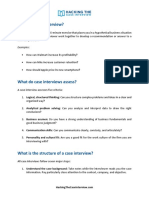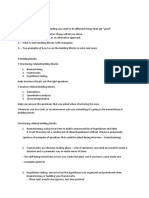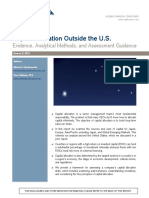100% found this document useful (1 vote)
813 views15 pagesThe Ultimate Case Interview Cheat Sheet and Study Guide
This document provides a case interview cheat sheet and study guide covering the key aspects of preparing for a case interview. It defines what a case interview is, what it assesses, the common structure and types of cases, important formulas and metrics to know, and tips for the interview. Specifically, it explains that a case interview is a simulated business problem where the interviewer and candidate work together to develop a recommendation. It also outlines the typical 7-step structure used to analyze and solve cases.
Uploaded by
Tejiri ArenCopyright
© © All Rights Reserved
We take content rights seriously. If you suspect this is your content, claim it here.
Available Formats
Download as PDF, TXT or read online on Scribd
100% found this document useful (1 vote)
813 views15 pagesThe Ultimate Case Interview Cheat Sheet and Study Guide
This document provides a case interview cheat sheet and study guide covering the key aspects of preparing for a case interview. It defines what a case interview is, what it assesses, the common structure and types of cases, important formulas and metrics to know, and tips for the interview. Specifically, it explains that a case interview is a simulated business problem where the interviewer and candidate work together to develop a recommendation. It also outlines the typical 7-step structure used to analyze and solve cases.
Uploaded by
Tejiri ArenCopyright
© © All Rights Reserved
We take content rights seriously. If you suspect this is your content, claim it here.
Available Formats
Download as PDF, TXT or read online on Scribd
/ 15

























































































